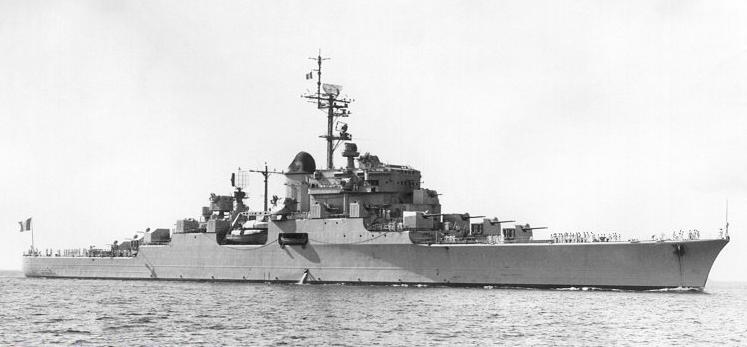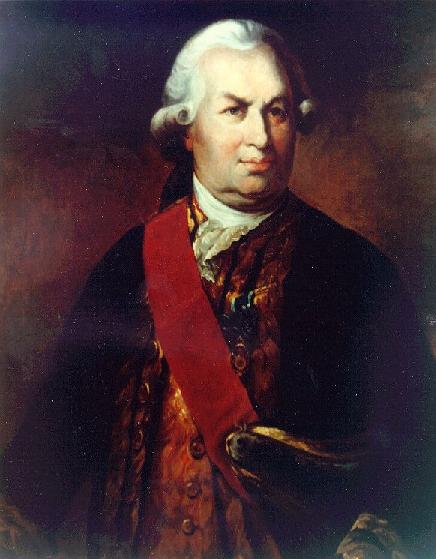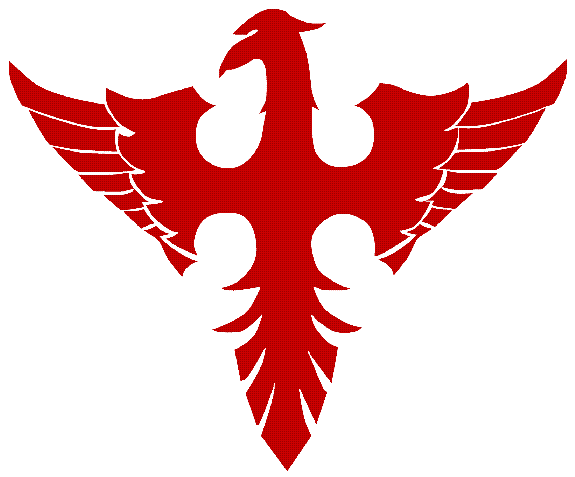From the end of the 1940 war year on, German naval leadership concerned itself-at least partially as a result of the successful British carrier-plane attack on the Italian fleet at Tarento with considerations as to how to remedy the lack of aircraft carriers most quickly. 
Kreigsmarine Aircraft Carriers - De Grasse Class ==========================================================================

A series of five cruisers and merchant ships were planned for conversion starting 5/1942 as an effort to provide a practical naval aviation force. None of the ships was ever completed as a carrier, and most conversions were never started. All were cancelled late in 1942 or early in 1943, when the carrier programs were cancelled. These were not sisterships, but are listed together for convenience. These vessels are commonly identified by their original names; new names had not been assigned prior to cancellation of the conversions.
Generally similar to GRAF ZEPPELIN. The conversion would have involved removal of existing superstructure and construction of a new flight deck, hangar, large island, and a heavy defensive battery. Details varied among the ships.
Subjects under discussion concerned not only the reconstruction of existing large warships, but also the adaptation of merchant ships, insofar as they seemed suitable in terms of size and speed. Included in these considerations were the battleships SCHARNHORST and GNEISENAU, as well as the heavy cruisers LUTZOW (a re-named pocket battleship formerly known as the "Deutschland") and ADMIRAL SCHEER on the one hand, and the passenger ships EUROPA and POTSDAM of the North German Lloyd line on the other.
The passenger ships were the only ones that met the basic requirements: the EUROPA was the largest, since the loss of the BREMEN to fire, weighing nearly 50,000 tons, and had a suitable top speed of 27 knots, while the POTSDAM, of only about 18,000 tons and a speed of 21 knots, were somewhat less well-suited though still usable. In addition, the rebuilding of the heavy cruiser SEYDLITZ, about 90% finished, seemed feasible, as opposed to converting the battleships of the SCHARNHORST class and the heavy cruisers LUTZOW and ADMIRAL SCHEER, which were then dropped from these considerations.
The creation of aircraft carriers was one of the main points in the Commander of the Navy's report to Hitler at the latter's headquarters on May 13, 1942. Thereupon Hitler decided that the EUROPA and POTSDAM should be rebuilt into auxiliary carriers. In a further report taking place on August 26, 1942 a further possibility was suggested: this involved the French cruiser DE GRASSE, lying on the slipway in Lorient, of which the rebuilding into an aircraft carrier seemed feasible.
The rebuilding plans for these ships were begun at once. In the process it was learned that the task had obviously been strongly underestimated and the difficulties that would necessarily arise in the construction of these ships, intended as they were for fully different purposes, had gone unrecognized. It was chiefly their form and weight stability and their inner division that were insufficient. It was believed that these problems could be mastered by applying a thick "armor plate" of heavy cement and building on side bulges, but this could not be achieved in a really satisfactory way and, in addition, brought about a limitation of their speed, which was not that great to begin with. The EUROPA-now designated "Auxiliary Aircraft Carrier I"-was to be rebuilt by Blohm & Voss in Hamburg-her builders-but this did not transpire: as early as November 25, 1942 the work of planning was halted and the rebuilding was cancelled even before the work had begun. The reason for this was the lack of stability even with the bulges built on, the problem of rigidity caused by the lowering of the hangar deck into the main formation deck, which could not be done any other way, and finally the expected very high fuel consumption when the ship was in use again.
The rebuilding of the other passenger ships was to be entrusted to the naval shipyards at the Howaldt Works of Hamburg , but with the cancellation of the rebuilding of the EUROPA, the contract for the POTSDAM was transferred to Blohm & Voss in November of 1942. With them too, problems of a very similar kind arose, especially in terms of stability, which were addressed with the same means-building on bulges and applying heavy concrete "armor plate."
According to a decision made on the same day, this was to be set up as a training aircraft carrier. The work actually began that December: in Kiel they began to remove the passenger cabins. In the midst of this work, it all came to an abrupt end on the basis of the aforementioned "Fuehrer’s Command."
The work of planning for the conversion of the uncompleted French heavy cruiser DE GRASSE, which began in April of 1942 under the designation "Auxiliary Aircraft Carrier II", led to this project being given up, as it was shown to be too expensive in terms of work and materials, was under ever· increasing danger of air attack, and finally, second thoughts about what from the German standpoint was an unsatisfactorily divided power system could not be allayed. At the beginning of February 1943 the planning work was halted.
After the spring of 1943 the navy had no possibility of any realizable construction of aircraft carriers.

Hilfsflugzeugträger Project II - French Cruiser De Grasse
The De Grasse was an unfinshed cruiser hull laid down for the French Navy in the late 1930s but not completed until 1954. She was named in honour of Admiral François Joseph Paul, marquis de Grasetilly, comte de Grasse, an 18th century French admiral. She was notorious for having been involved in the nuclear test campaigns in Mururoa.
Built by Arsenal de Lorient as a French light cruiser Laid down 11/1938, suspended at the outbreak of war. Conversion abandoned 2/1943. Returned to Franch postwar, launched 11 August 1946 and completed 3 September 1956 as anti-aircraft cruiser DeGrasse. Reconstructed 1966 as a command cruiser. Stricken 1973 and subsequently scrapped.
The De Grasse was designed in the late 1930s, as the lead ship of a series of three cruisers a little heavier than the preceding La Galissonnière class cruisers , notably with an improved anti-aircraft equipment. (The other two sister ships Chateaurenault and Guichen were cancelled.)
This ship was designed specifically as an anti-aircraft ship, armed solely with 127mm and 57mm heavy AA guns in multiple turrets (in its final form; its original design was a light cruiser armed with 6" guns). De Grasse was also equipped as an aircraft control ship, able to direct friendly carrier-based aircraft.
When Germany invaded France in 1940, several ships were captured in French shipyards, including the incomplete cruiser De Grasse. At the end of 1940 it became obvious that the Kriegsmarine badly needed aircraft carriers to support naval operations of the surface fleet. Since the construction of new aircraft carriers would have taken too long, several existing ships were considered for being converted to aircraft carriers. Ideas to convert the battlecruisers Scharnhorst and Gneisneau and the Panzerschiffe Admiral Scheer and Lützow were soon withdrawn, instead several passenger ships and two incomplete captured cruisers were chosen. (None of these ships were ever fully completed as an actual aircraft carrier.) One of the hulls considered by the germans to convert to a light aircraft carrier was the incomplete De Grasse hull. Although this had to be done in its original shipyard in Lorries, detailed plans were made.
In August 1942 the Germans began converting De Grasse into an auxiliary aircraft carrier but the construction was halted in February 1943 since it proved to be too expensive in terms of work and material costs and the whole project was in danger because of increasing Allied air raids and sabotage.
After the war the hull was eventually launched in 1946. Then construction was halted again between 1946 and 1951, when she was towed to Brest to be completed, to a significantly modified design as an anti-aircraft cruiser. The trials began on 17 August 1954 and she was commissioned on 10 September 1956.
She was used as an anti-aircraft cruiser within the Atlantic squadron, until she joined the Pacific Experimentation Centre to participate in the first nuclear tests in French Polynesia. She undertook some modification in 1965, with the bridge being doubled, a quadripod mast mounted on the aft roof and half the armament removed. The ship was also made gas-tight and fitted with washdown facilities. The equipment was modernised and the crew was downsized to 560 men, to make accommodation available for 160 engineers and technicians.
The ship was used for six testing campaigns between 1966 and 1972. She was refitted to act as a control ship for nuclear weapons testing in the Pacific. Much of her armament was removed, the bridge rebuilt, and a large mast added aft.
She decommissioned in 1973 and was scrapped on 25 January 1974, but her near-sister ship Colbert (laid down after WW2, but very similar in design, though it was later refitted with missile armament) survives as a museum ship, though this ship may also be scrapped in future due to lack of funds.

Comte de Grasse aided the fledgling US Navy during the Revolutionary War.
In 1776, the American War of Independence against Great Britain began and the French Navy was assigned to assist the American cause. As a commander of a division, de Grasse served under Louis Guillouet, comte d'Orvilliers at the First Battle of Ushant from July 23 to 27, 1778. In 1779, he joined the fleet of Count d'Estaing in the Caribbean and distinguished himself in the battles of Dominica and Saint Lucia during 1780 and of Tobago during 1781. He contributed to the capture of Grenada and took part in the three actions fought by Guichen against Admiral Rodney in the Battle of Martinique.
He came to the aid of Washington and Rochambeau, setting sail with 3,000 men from Saint-Dominique. De Grasse landed the 3,000 French reinforcements in Virginia, and immediately afterwards decisively defeated the British fleet in the Battle of the Chesapeake in September 1781. He drew away the English forces and blockaded the coast until Lord Cornwallis surrendered, ensuring the independence of the United States of America.
He was less fortunate at Battle of St. Kitts, where he was defeated by Admiral Hood. Shortly afterwards, in April 1782, he was defeated and taken prisoner by Admiral Rodney at the Battle of the Saintes. Some months later, he returned to France, published a Mémoire justificatif and, in 1784, was acquitted by a court-martial.
An interesting side-note about the town of Grasse (as in De Grasse); Prince Eugen of Bavaria died on January 1, 1997 at Grasse in the Alpes-Maritimes region of France. He is buried at the Andechs Abbey cemetery in Bavaria.
=================================================================================
NB: The above text has been collected / excerpted / edited / mangled / tangled / re-compiled / etc ... from the following online sources :
KM - Cruiser De Grasse - www.epmodels.co.uk
KM - Carrier De Grasse - www.german-navy.de
KM - German Auxiliary Fleet Carrier Program - http://www.hazegray.org
KM - German Auxiliary Fleet Carrier Program - h863.org
KM - French Cruiser DeGrasse - www.german-navy.de
KM - French Cruiser DeGrasse - www.absoluteastronomy.com
KM - French Cruiser DeGrasse - wikipedia article # 1
KM - French Cruiser de Grasse - wikipedia article # 2
Comte de Grasse - wikipedia article # 3
Prinz Eugen - wikipedia article # 4


